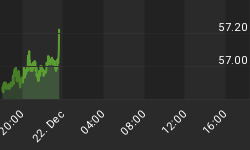In a recent commentary we looked at how the true rate of inflation is actually a lot less severe than the pundits would have us believe. We also examined the possibility for a "contained" oil price in 2005. In other words, it appears that the Fed wants to keep inflation from heating up again for a while in order to give the markets a respite. This attempt at battling inflation will mean that China will most likely be kept from breaking out this year and the crude oil price will be "capped" probably below the $58-$60 area for the remainder of the year. Meanwhile, oil appears to be settling into its new interim trading range as discussed in previous commentaries.
The latest crude oil price graph below shows that a lingering wave of upside momentum, as reflected in the 200-day moving average, has come to the rescue for the oil price to provide temporary support. Oil should be able to remain buoyant for a while considering that its 90-day and 200-day moving averages are still rising, with a zone of resistance between $52.00-$54.00 and support around the $47.00 area.

As we've looked at in the past few months, one of the dominant themes this year so far has been the significant slowdown in money supply growth and the probability for an economic slowdown to be felt by later this year. Obviously this would have an impact on oil demand, as a decrease in liquidity would put a damper on the oil market to some extent, especially once this slowdown hits the much bigger global economy.
As one Ed Yardeni has pointed out in his recent commentaries, the sharp drop in the growth of global liquidity since last summer suggests that oil demand growth will slow soon as well, and this has already started. As Yardeni has emphasized, "The growth in Foreign Official Dollar Reserves (FRODOR) is a....12-month leading indicator of the growth in world crude oil demand....The 52-week growth rate of FRODOR is down to 15.8% during the week of March 29 from the latest cyclical peak of 36.2% during the week of August 18, 2004. The slowing in global liquidity suggests that global demand growth should peak soon..."
Check out the latest chart showing the 3-month rate of change in M1 money supply, courtesy of BullandBearwise.com. The drop in M1 ROC has been pronounced to say the least and has been the biggest rate of change decline since 2002.

This brings us to the headline for this article involving inflation and Wal-Mart. Recent earnings announcements by several major companies, including Wal-Mart, alluded to the effects that the high petroleum costs of the past year have had on profits and projections. This has been true in varying degrees for much of corporate America. And since the coming economic slowdown will most likely be felt by consumers in particular (while business spending will likely not be as affected), I think it's safe to say that one reason why oil is being "capped" now is to allow the Wal-Marts of the world to recover from the oil-related "dislocations" of the past year.















